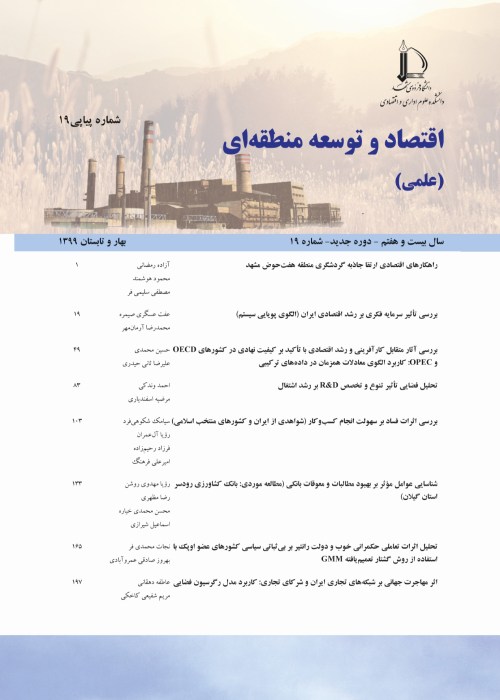Investigating Energy Consumption Performance in Iranian Provinces: Index Decomposition Analysis
Author(s):
Article Type:
Research/Original Article (دارای رتبه معتبر)
Abstract:
Introduction
Decomposition analysis has been extensively used to study the factors of changes of an aggregate indicator over time. Two popular decomposition techniques include index decomposition analysis (IDA) and structural decomposition analysis (SDA). These popular techniques in energy and emission have been developed independently.For almost two decades, the most widely used index decomposition analysis (IDA) approaches in energy and energy-related gas emission studies have been formulated using Laspeyres and Divisia index. Index decomposition analysis is now a popular analytical tool for policymaking in the national energy and environmental issues (Ang & Zhang, 2000).
Methodology
The basic IDA identity in energy consumption studies is used to illustrate spatial decomposition analysis for two regions. Assuming that energy consumption of a region is divided into m sectors. Considering that E is the total energy consumption and is the energy consumption in sector i, A is the overall activity level; Ai is the activity level of sector i; Si is the activity share of sector i (=Ai/A); I is the aggregate energy intensity (=E/A), and Ii is the energy intensity of sector i: E = = When the aggregate energy consumption of the two regions (Region 1 & Region 2) is compared, we may choose the one with a lower consumption (assuming it to be Region 2) as the base region in the comparison. In spatial decomposition analysis, the difference in the aggregate energy consumption between the two regions, denoted as , is decomposed to give the following:where the terms on the right give the effects associated with differences between the two regions at the overall activity level, the activity mix and the sectoral energy intensity, respectively. In IDA terminology, they are referred to as the activity effect, activity structure effect and energy intensity effect respectively.
Policy makers may wish to know why there are differences among countries, or provinces or states within a country. They also wish to know the implications of these differences and the best course of action to take.
For these purposes, the use of the bilateral– regional (B–R) model or radial–regional (R–R) model provides useful but incomplete information. A more elaborate spatial decomposition analysis model is needed, which we shall introduce in this section.
To reduce the number of decomposition factors and at the same time to avoid the arbitrariness of choosing a benchmark reference in a multi-region spatial decomposition analysis, one solution is to compare each of the target regions with a reference entity given by the mean of the entire group. In energy decomposition analysis, this reference entity has the energy consumption for each sector, and it also has the activity level given by the arithmetic mean of the corresponding values for all the regions in the comparison group. The activity structure and energy intensity for the entity are then calculated from these group mean values (Ang, Xu, & Su, 2015).
We call this multi-regional (M-R) spatial decomposition analysis model, in which the relationships between any of the two regions are obtained indirectly through the results of two relevant direct decomposition analyses. Hence, for a comparison group consisting of n regions, n direct decomposition cases are conducted between each member and the group mean, and sets of indirect results that can be derived to allow a comparison between any of the two regions. The indirect results for Region 1 and Region 2 are estimated in the following formula:where Rμ refers to the benchmark reference, which is the group mean.
Results and Conclusion
In this study, spatial analysis using multi-regional (M-R) model for energy consumption in 2012 was carried out in 31 provinces of Iran. According to the intensity effect based on the obtained ranking, the results of the study showed that Sistan and Baluchestan had the lowest power for saving with a rating of 1, while Tehran had the most power for saving with the rating of 31. The mean national intensity effect was 358,46 million tons of coal equivalent. The provinces which are below the national mean intensity effects had higher savings and lower energy consumption. Kerman Province was first province due to the structure effect of Kerman Province, whereas Khuzestan Province was ranked as the 31st province. They respectively had the minimum and maximum intensity of the industrial structure. The national mean of industrial structure was -77.38 Million tons of coal equivalent which represent the optimal performance of a small number of industry structure governorates. The national mean of activity effect is equivalent to the -282.07 million tons of coal, where the 11 provinces are at the top of this range. The ranking of different regions of country are respectively region 5, region 2, region 3, region 4, and region 1 for intensity effect; region 2, region 5, region 1, region 4, and region 3 for structural effect, and finally region 4, region 1, region 3, region 5 and region 2 for activity effect.Keywords:
Language:
Persian
Published:
Journal of Economy and Regional Development, Volume:25 Issue: 16, 2019
Pages:
57 to 86
magiran.com/p1967946
دانلود و مطالعه متن این مقاله با یکی از روشهای زیر امکان پذیر است:
اشتراک شخصی
با عضویت و پرداخت آنلاین حق اشتراک یکساله به مبلغ 1,390,000ريال میتوانید 70 عنوان مطلب دانلود کنید!
اشتراک سازمانی
به کتابخانه دانشگاه یا محل کار خود پیشنهاد کنید تا اشتراک سازمانی این پایگاه را برای دسترسی نامحدود همه کاربران به متن مطالب تهیه نمایند!
توجه!
- حق عضویت دریافتی صرف حمایت از نشریات عضو و نگهداری، تکمیل و توسعه مگیران میشود.
- پرداخت حق اشتراک و دانلود مقالات اجازه بازنشر آن در سایر رسانههای چاپی و دیجیتال را به کاربر نمیدهد.
In order to view content subscription is required
Personal subscription
Subscribe magiran.com for 70 € euros via PayPal and download 70 articles during a year.
Organization subscription
Please contact us to subscribe your university or library for unlimited access!



